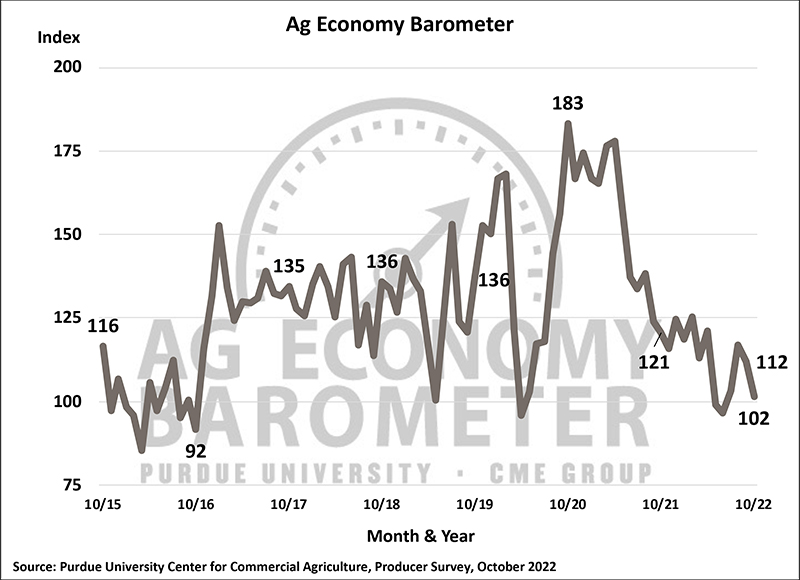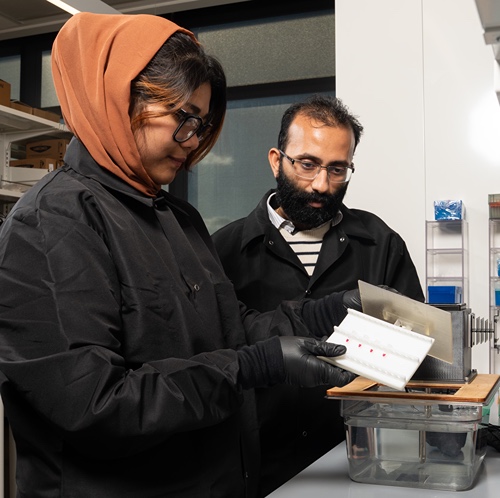Ag Economy Barometer declines again, producers express concern about interest rate policy
Farmer sentiment weakened again in October as the Purdue University/CME Group Ag Economy Barometer dropped 10 points to a reading of 102. Both barometer’s sub-indices also declined this month. The Current Conditions Index dipped 8 points to a reading of 101, while the Future Expectations Index dropped 11 points to a reading of 102. The “Ag Economy Barometer” is calculated each month from 400 U.S. agricultural producers’ responses to a telephone survey. This month’s survey was conducted Oct. 10-14.
“Concern over rising interest rates grew once again in October and is adding to the unease among producers who are worried about its impact on their farm operations,” said James Mintert, the barometer’s principal investigator and director of Purdue University’s Center for Commercial Agriculture. “Additionally, challenging shipping conditions throughout the Mississippi River valley have hampered exports recently, and the corresponding widespread weakening of corn and soybean basis levels could be contributing to heightened unease about financial performance.”
Producer concern about the financial performance of their farms was one of the primary drivers of weakening sentiment in October. The Farm Financial Performance Index fell 13 points this month to 86 and was a distillation of producers’ concerns about high input costs combined with weaker commodity prices. Looking ahead to next year, over 40% of producers viewed high input costs as their top concern, followed by 21% who chose rising interest rates, 13% who chose lower output prices and 13% who chose input availability.
After dipping to a new record low last month, the Farm Capital Investment Index improved 7 points this month to a reading of 38. Producers who viewed this as a bad time for large investments revealed that increasing prices for farm machinery and new construction (40% of respondents) was the primary reason for their negative outlook, followed by rising interest rates (20%) and uncertainty about farm profitability (17%).
Producers’ expectations for short- and long-term farmland values rose this month. The Short-Term Farmland Value Expectation Index rose 10 points to a reading of 133, while the Long-Term Farmland Value Index rose 5 points to 144. Strength in both indices comes on the heels of reports from farmland auctions around the Corn Belt that land values are setting new record highs again this fall. Even with this month’s rise, both indices remain weaker than a year earlier. The short-term index this month was 15% lower and the long-term index was 11% lower than in October 2021.
Farm policy discussions are underway as Congress prepares for debate on a new Farm Bill in 2023. As a result, several farm policy related questions were included in this month’s barometer survey. Crop producers were asked which two policies or programs would be most important to their farm in the upcoming five years. More than one-third (36%) of crop producers chose interest rate policy as the most important policy issue for their farming operation, followed by the crop insurance program (27%), environmental policy (16%), conservation policy (11%) and climate policy (10%). When asked how effective the current ARC-County and Price Loss Coverage (PLC) programs are at providing a financial safety net, 72% of respondents rated the two programs as either “somewhat effective” (61%) or “very effective” (11%). When the same question was posed relative to crop insurance, 84% of respondents rated it as either “somewhat effective” (56%) or “very effective” (28%).
Read the full Ag Economy Barometer report. The site also offers additional resources – such as past reports, charts and survey methodology – and a form to sign up for monthly barometer email updates and webinars.
Each month, the Purdue Center for Commercial Agriculture provides a short video analysis of the barometer results. For even more information, check out the Purdue Commercial AgCast podcast. It includes a detailed breakdown of each month’s barometer, in addition to a discussion of recent agricultural news that affects farmers.
The Ag Economy Barometer, Index of Current Conditions and Index of Future Expectations are available on the Bloomberg Terminal under the following ticker symbols: AGECBARO, AGECCURC and AGECFTEX.
About the Purdue University Center for Commercial Agriculture
The Center for Commercial Agriculture was founded in 2011 to provide professional development and educational programs for farmers. Housed within Purdue University’s Department of Agricultural Economics, the center’s faculty and staff develop and execute research and educational programs that address the different needs of managing in today’s business environment.
About CME Group
As the world’s leading and most diverse derivatives marketplace, CME Group (www.cmegroup.com) enables clients to trade futures, options, cash and OTC markets, optimize portfolios, and analyze data – empowering market participants worldwide to efficiently manage risk and capture opportunities. CME Group exchanges offer the widest range of global benchmark products across all major asset classes based on interest rates, equity indexes, foreign exchange, energy, agricultural products and metals. The company offers futures and options on futures trading through the CME Globex® platform, fixed income trading via BrokerTec and foreign exchange trading on the EBS platform. In addition, it operates one of the world’s leading central counterparty clearing providers, CME Clearing. With a range of pre- and post-trade products and services underpinning the entire lifecycle of a trade, CME Group also offers optimization and reconciliation services through TriOptima, and trade processing services through Traiana.
CME Group, the Globe logo, CME, Chicago Mercantile Exchange, Globex, and E-mini are trademarks of Chicago Mercantile Exchange Inc. CBOT and Chicago Board of Trade are trademarks of Board of Trade of the City of Chicago, Inc. NYMEX, New York Mercantile Exchange and ClearPort are trademarks of New York Mercantile Exchange, Inc. COMEX is a trademark of Commodity Exchange, Inc. BrokerTec, EBS, TriOptima, and Traiana are trademarks of BrokerTec Europe LTD, EBS Group LTD, TriOptima AB, and Traiana, Inc., respectively. Dow Jones, Dow Jones Industrial Average, S&P 500, and S&P are service and/or trademarks of Dow Jones Trademark Holdings LLC, Standard & Poor’s Financial Services LLC and S&P/Dow Jones Indices LLC, as the case may be, and have been licensed for use by Chicago Mercantile Exchange Inc. All other trademarks are the property of their respective owners.







